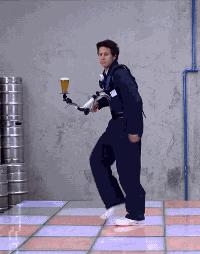In the field of photography, people have made great efforts to "stabilize": not only do photographers have to practice "iron fist", but people have also developed a variety of special anti-shake equipment.

Mechanical stabilization gimbal (Steadicam system), but this usage is a bit strange...
However, no matter how high-end artificial stabilization technology is, people will always recall a sword-and-edge solution. It is back to basics, all-natural, low cost, simple operation, excellent results... Yes, that's --
"Tie the chicken head"
The body moves, the head does not move. This is actually a classic shot in a certain advertising film.
just don't move! | SmarterEveryDay
In those GIFs that spread across the Internet, the chicken head that is as stable as Taishan will always have a place. There are even netizens who have evaluated the stability of the "chicken head camera". Compared to the person holding and wearing the camera, the picture taken by the chicken head is indeed more stable, but it is impossible to control which side of the chicken looks at the hard wound of the device...
From left to right: on a human head, on a chicken head, holding a | jeremiahjw
Why is the chicken head stable? How powerful is this "racial talent"?
How good is bird head stabilization?
In birds, head "anti-shake" is a very common phenomenon. In addition to chicken heads, there are many examples of bird heads "anti-shake", such as pigeons that "nod" while walking. They're not trying to get out of the most swinging rhythm, but to keep their heads steady for most of the time they're on the move, and then chua to the next position.
Head movements when the pigeon is walking
Birds are sensitive to the perception of spatial changes, and as long as the head has a slight displacement, they can perceive it through changes in the relative position of objects in the field of vision, so as to make corresponding adjustments. The displacement of the head of the walking pigeon can be controlled within 0.5 mm during the "stabilization period", and bird species that rely on spatial judgment, such as hummingbirds, kingfishers and tea falcons, will have higher "anti-shake performance".
Hummingbirds hovering in the air are an excellent example of head stabilization | BBC Earth Unplugged
Visual stabilization? Actually, you can do it
It is generally believed that the stable head of birds is to maintain a stable line of sight, which is actually a very common phenomenon in the animal kingdom. When individual animals are in a certain visual environment, they often instinctively lock the center of their field of vision on a certain point, or on a certain object. If you try to turn your head left and right, you'll also find that your gaze probably doesn't move slowly with your head, but jumps from a steady point to the next.
Keeping your sight steady is good for the animal's survival, because eliminating the distractions of eye shaking makes it easier to identify targets that are really moving—targets that could be a lunch, a hostile competitor, or a menacing predator. We actually have the same mechanism to adjust the stability of the line of sight, but human "visual stabilization" relies more on flexible rotating eyeballs. Because of the dependence of flight on vision, birds' eyeballs are so developed that they occupy almost all the space in the orbits, while at the same time their eye movements are limited. So when birds want to adjust their gaze, they rely on flexible necks.
Relying on the neck to maintain visual stability as much as possible is also a trick that humans can use – look at the dancers who circle
In addition, some scientists believe that the "one to one meal" pattern of the head when birds walk can also produce parallax of motion, helping to provide information about the depth and distance of objects. This explanation seems reasonable, but it has not been directly confirmed.
In order to achieve a stable field of view, both the vision system and the balance system are involved in the adjustment. Studies have also found that birds like hummingbirds, which are exceptionally good at maintaining stability in the air, also have larger associated brain areas than other birds.
Follow ornithological stabilization
Strapping a camera directly to a chicken's head isn't a good idea, but from birds, researchers do find inspiration for improving stability.
In 2015, engineers at Stanford University used high-speed cameras to record the movements of the head and neck of swans as they flew over the lake. The swans' bodies sway up and down as they flapp their wings, but with the adjustment of their necks, their heads remain fairly stable. Some UAV reconnaissance aircraft also use the flapping wing design, recording the process of adjusting the head of the bird in flight, and building a model to simulate it, so that the results are used in the UAV, and the picture captured can become clearer.
Turn "bird head stabilization" into a physical model
In any case, bird heads are indeed an impressive example of the stability of the visual system. Maybe one day, the cameras in our hands will be as stable as tarzan.
Author: Colchicine
EDIT: Window knocking rain
A stabilization AI
This article is from the fruit shell and may not be reproduced without authorization.